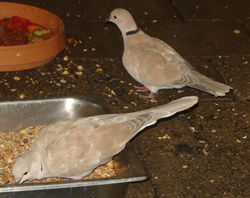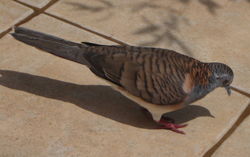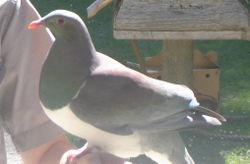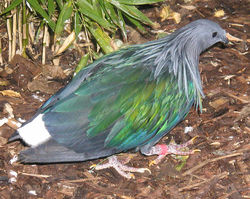Dove
2007 Schools Wikipedia Selection. Related subjects: Birds
| iPigeons and Doves | ||||||||||
|---|---|---|---|---|---|---|---|---|---|---|
 Rock Pigeon (Columba livia)
|
||||||||||
| Scientific classification | ||||||||||
|
||||||||||
|
|
||||||||||
|
see article text |
Pigeons and doves are some 300 species of near passerine birds in the order Columbiformes. In general parlance the terms "dove" and "pigeon" are used somewhat interchangeably. In ornithological practice there is a tendency for "dove" to be used for smaller species and "pigeon" for larger ones, but this is in no way consistently applied, and historically the common names for these birds involve much variation between "dove" and "pigeon".
The species commonly referred to just as the "pigeon" is the feral Rock Pigeon, common in many cities.
Pigeons and doves are stout-bodied birds with short necks and short slender bills with a fleshy cere.
The usually flimsy nests are made of sticks, and the two white eggs are incubated by both sexes. Doves feed on seeds, fruit and other soft plantstuff. Unlike most other birds (but see flamingo), the doves and pigeons produce " crop milk", which is secreted by a sloughing of fluid-filled cells from the lining of the crop. Both sexes produce this highly nutritious substance to feed to the young.
This family occurs worldwide, but the greatest variety is in the Indomalaya and Australasia ecozones. It is related to the extinct dodo. The young doves and pigeons are called "squabs".
Systematics and evolution
The family is usually divided into five subfamilies, but this is probably inaccurate. For example, the American ground and quail doves which are usually placed in the Columbinae seem to be two distinct subfamilies. The order presented here follows Baptista et al. (1997) with some updates (Johnson & Clayton, 2000; Johnson et al., 2001; Shapiro et al., 2002).
Note that the arrangement of genera and naming of subfamilies is in some cases provisional because analyses of different DNA sequences yield results that differ, often radically, in the placement of certain (mainly Indo-Australian) genera. This ambiguity, probably caused by Long branch attraction, on the other hand seems to confirm that the first pigeons evolved in the Australasian region, and that the "Treronidae" and allied forms (crowned and pheasant pigeons, for example) represent the earliest radiation of the group.
Exacerbating these issues, columbids are not well represented in the fossil record. No really primitive forms have been found to date. The genus Gerandia which most likely belongs to the Columbinae has been described from Early Miocene deposits of France. Apart from that, all other fossils belong to extant genera. For these, and for the considerable number of more recently extinct prehistoric species, see the respective genus accounts.
Subfamily Columbinae—typical pigeons & doves
Genus Columba (Old World pigeons)
- Rock Pigeon, Columba livia
- Domestic pigeon or feral pigeon, Columba livia domestica
- Stock Pigeon, Columba oenas
- Trocaz Pigeon, Columba trocaz
- Bolle's Pigeon, Columba bollii
- Laurel Pigeon, Columba junoniae
- Hill Pigeon, Columba rupestris
- Snow Pigeon, Columba leuconota
- Speckled Pigeon, Columba guinea
- White-collared Pigeon, Columba albitorques
- Pale-backed Pigeon, Columba eversmanni
- Somali Pigeon, Columba oliviae
- Wood Pigeon, Columba palumbus
- Afep Pigeon, Columba unicincta
- African Olive Pigeon, Columba arquatrix
- Cameroon Olive Pigeon, Columba sjostedti
- Sao Tome Olive Pigeon, Columba thomensis
- Comoro Olive Pigeon, Columba polleni
- Speckled Wood-pigeon, Columba hodgsonii
- White-naped Pigeon, Columba albinucha
- Ashy Wood-pigeon, Columba pulchricollis
- Nilgiri Wood-pigeon, Columba elphinstonii
- Sri Lanka Wood-pigeon, Columba torringtoni
- Pale-capped Pigeon, Columba punicea
- Silvery Pigeon, Columba Argentina (possibly extinct)
- Andaman Wood-pigeon, Columba palumboides
- Japanese Wood-pigeon, Columba janthina
- Bonin Wood-pigeon, Columba versicolor ( extinct)
- Ryukyu Wood-pigeon, Columba jouyi ( extinct)
- Metallic Pigeon or White-throated Pigeon, Columba vitiensis
- White-headed Pigeon, Columba leucomela
- Yellow-legged Pigeon, Columba pallidiceps

- Eastern Bronze-naped Pigeon, Columba delegorguei
- Western Bronze-naped Pigeon, Columba iriditorques
- Sao Tome Bronze-naped Pigeon, Columba malherbii
- African Lemon-dove, Columba larvata
- Sao Tome Lemon-dove, Columba simplex
Genus Streptopelia (turtledoves)
- Laughing Dove Streptopelia senegalensis (may be distinct genus Stigmatopelia)
- Spotted Dove Streptopelia chinensis (may be distinct genus Stigmatopelia)
- Collared Dove Streptopelia decaocto
- Barbary Dove Streptopelia risoria (domesticated; taxonomic status doubtful)
- African Collared Dove, Streptopelia roseogrisea
- Turtle Dove Streptopelia turtur
- Oriental Turtle Dove Streptopelia orientalis
- Dusky Turtle Dove, Streptopelia lugens
- Adamawa Turtle Dove, Streptopelia hypopyrrha
- Island Collared Dove, Streptopelia bitorquata
- White-winged Collared Dove, Streptopelia reichenowi
- African Mourning Dove, Streptopelia decipiens
- Red-eyed Dove, Streptopelia semitorquata
- Ring-necked Dove, Streptopelia capicola
- Vinaceous Dove, Streptopelia vinacea
- Red Turtle Dove, Streptopelia tranquebarica
- Madagascar Turtle Dove, Streptopelia picturata (may be distinct genus Nesoenas)
- Rodrigues Turtle Dove, Streptopelia rodericana ( extinct; may be distinct genus Nesoenas)
- Pink Pigeon, Streptopelia mayeri (may be distinct genus Nesoenas)
- Réunion Pink Pigeon, Streptopelia duboisi ( extinct; may be distinct genus Nesoenas)
Genus Patagioenas (American pigeons; formerly included in Columba)
- White-crowned Pigeon, Patagioenas leucocephala
- Scaly-naped Pigeon, Patagioenas squamosa
- Scaled Pigeon, Patagioenas speciosa
- Picazuro Pigeon, Patagioenas picazuro
- Bare-eyed Pigeon, Patagioenas corensis
- Spot-winged Pigeon, Patagioenas maculosa
- Band-tailed Pigeon, Patagioenas fasciata
- Chilean Pigeon, Patagioenas araucana
- Ring-tailed Pigeon, Patagioenas caribaea
- Pale-vented Pigeon, Patagioenas cayennensis
- Red-billed Pigeon, Patagioenas flavirostris
- Peruvian Pigeon, Patagioenas oenops
- Plain Pigeon, Patagioenas inornata
- Plumbeous Pigeon, Patagioenas plumbea
- Ruddy Pigeon, Patagioenas subvinacea
- Short-billed Pigeon, Patagioenas nigrirostris
- Dusky Pigeon, Patagioenas goodsoni
Genus Macropygia
- Barred Cuckoo-dove, Macropygia unchall
- Slender-billed Cuckoo-dove, Macropygia amboinensis
- Brown Cuckoo-dove, Macropygia phasianella
- Dusky Cuckoo-dove, Macropygia magna
- Andaman Cuckoo-dove, Macropygia rufipennis
- Philippine Cuckoo-dove, Macropygia tenuirostris
- Ruddy Cuckoo-dove, Macropygia emiliana
- Black-billed Cuckoo-dove, Macropygia nigrirostris
- Mackinlay's Cuckoo-dove, Macropygia mackinlayi
- Little Cuckoo-dove, Macropygia ruficeps
Genus Reinwardtoena
- Great Cuckoo-dove, Reinwardtoena reinwardtii
- Pied Cuckoo-dove, Reinwardtoena browni
- Crested Cuckoo-dove, Reinwardtoena crassirostris
Genus Turacoena
- White-faced Cuckoo-dove, Turacoena manadensis
- Black Cuckoo-dove, Turacoena modesta
Subfamily N.N.—Bronzewings and relatives
Genus Turtur (African wood doves; subfamily assignment unclear)
- Emerald-spotted Wood Dove, Turtur chalcospilos
- Black-billed Wood Dove, Turtur abyssinicus
- Blue-spotted Wood Dove, Turtur afer
- Tambourine Dove, Turtur tympanistria
- Blue-headed Wood Dove, Turtur brehmeri
Genus Oena (subfamily assignment unclear)
- Namaqua Dove, Oena capensis
Genus Chalcophaps
- Emerald Dove, Chalcophaps indica
- Stephan's Dove, Chalcophaps stephani
Genus Henicophaps
- New Guinea Bronzewing, Henicophaps albifrons
- New Britain Bronzewing, Henicophaps foersteri
Genus Phaps
- Common Bronzewing, Phaps chalcoptera
- Brush Bronzewing, Phaps elegans
- Flock Bronzewing, Phaps histrionica
Genus Ocyphaps
- Crested Pigeon, Ocyphaps lophotes
Genus Geophaps
- Spinifex Pigeon, Geophaps plumifera
- Squatter Pigeon, Geophaps scripta
- Partridge Pigeon, Geophaps smithii
Genus Petrophassa, rock pigeons
- Chestnut-quilled Rock Pigeon, Petrophassa rufipennis
- White-quilled Rock Pigeon, Petrophassa albipennis
Genus Geopelia
- Diamond Dove, Geopelia cuneata
- Zebra Dove, Geopelia striata
- Peaceful Dove, Geopelia placida
- Barred Dove, Geopelia maugei
- Bar-shouldered Dove, Geopelia humeralis
Subfamily Leptotilinae—Zenaidine and quail doves
Genus Zenaida
- White-winged Dove, Zenaida asiatica
- Pacific Dove, Zenaida meloda
- Zenaida Dove, Zenaida aurita
- Galapagos Dove, Zenaida galapagoensis
- Eared Dove, Zenaida auriculata
- Mourning Dove, Zenaida macroura
- Socorro Dove, Zenaida graysoni ( extinct in the wild)
Genus Ectopistes
- Passenger Pigeon Ectopistes migratorius ( extinct)
Genus Leptotila
- White-tipped Dove, Leptotila verreauxi
- White-faced Dove, Leptotila megalura
- Grey-fronted Dove, Leptotila rufaxilla
- Grey-headed Dove, Leptotila plumbeiceps
- Pallid Dove, Leptotila pallida
- Brown-backed Dove, Leptotila battyi
- Grenada Dove, Leptotila wellsi
- Caribbean Dove, Leptotila jamaicensis
- Grey-chested Dove, Leptotila cassini
- Ochre-bellied Dove, Leptotila ochraceiventris
- Tolima Dove, Leptotila conoveri
Genus Geotrygon, quail-doves
- Purplish-backed Quail-Dove, Geotrygon lawrencii
- Veracruz Quail-Dove, Geotrygon carrikeri
- Costa Rica Quail-Dove, Geotrygon costaricensis
- Russet-crowned Quail-Dove, Geotrygon goldmani
- Sapphire Quail-Dove, Geotrygon saphirina
- Grey-headed Quail-Dove, Geotrygon caniceps
- Crested Quail-Dove, Geotrygon versicolor
- Rufous-breasted Quail-Dove, Geotrygon chiriquensis
- Olive-backed Quail-Dove, Geotrygon veraguensis
- White-faced Quail-Dove, Geotrygon albifacies
- Lined Quail-Dove, Geotrygon linearis
- White-throated Quail-Dove, Geotrygon frenata
- Key West Quail-Dove, Geotrygon chrysia
- Bridled Quail-Dove, Geotrygon mystacea
- Violaceous Quail-Dove, Geotrygon violacea
- Ruddy Quail-Dove, Geotrygon montana
Genus Starnoenas
- Blue-headed Quail-Dove, Starnoenas cyanocephala
Subfamily Columbininae—American ground doves
Genus Columbina
- Common Ground Dove, Columbina passerina
- Plain-breasted Ground Dove, Columbina minuta
- Ecuadorian Ground Dove, Columbina buckleyi
- Ruddy Ground Dove, Columbina talpacoti
- Picui Dove, Columbina picui
- Croaking Ground Dove, Columbina cruziana
- Blue-eyed Ground Dove, Columbina cyanopis
Genus Claravis
- Blue Ground Dove, Claravis pretiosa
- Purple-winged Ground Dove, Claravis godefrida
- Maroon-chested Ground Dove, Claravis mondetoura
Genus Metropelia
- Bare-faced Ground Dove, Metriopelia ceciliae
- Moreno's Ground Dove, Metriopelia morenoi
- Black-winged Ground Dove, Metriopelia melanoptera
- Golden-spotted Ground Dove, Metriopelia aymara
Genus Scardafella
- Inca Dove, Scardafella inca
- Scaled Dove, Scardafella squammata
Genus Uropelia
- Long-tailed Ground Dove, Uropelia campestris...
Subfamily N.N.—Indopacific ground doves
Genus Gallicolumba
- Luzon Bleeding-heart, Gallicolumba luzonica
- Mindanao Bleeding-heart, Gallicolumba crinigera (criniger is a spelling error in the description)
- Mindoro Bleeding-heart, Gallicolumba platenae
- Negros Bleeding-heart, Gallicolumba keayi
- Sulu Bleeding-heart, Gallicolumba menagei (possibly extinct)
- Cinnamon Ground Dove, Gallicolumba rufigula
- Sulawesi Ground Dove, Gallicolumba tristigmata
- White-bibbed Ground Dove, Gallicolumba jobiensis
- Caroline Ground Dove, Gallicolumba kubaryi
- Polynesian Ground Dove, Gallicolumba erythroptera
- White-throated Ground Dove, Gallicolumba xanthonura
- Friendly Ground Dove, Gallicolumba stairi
- Tanna Ground Dove, Gallicolumba ferruginea ( extinct)
- Santa Cruz Ground Dove, Gallicolumba sanctaecrucis
- Thick-billed Ground Dove, Gallicolumba salamonis ( extinct)
- Marquesas Ground Dove, Gallicolumba rubescens
- Bronze Ground Dove, Gallicolumba beccarii
- Palau Ground Dove, Gallicolumba canifrons
- Wetar Ground Dove, Gallicolumba hoedtii
- Norfolk Island Ground Dove, Gallicolumba norfolciensis ( extinct)
Genus Trugon
- Thick-billed Ground Pigeon, Trugon terrestris
Subfamily Otidiphabinae—Pheasant Pigeon
Genus Otidiphaps
- Pheasant Pigeon, Otidiphaps nobilis
Subfamily Didunculinae—tooth-billed pigeon
Genus Didunculus
- Tooth-billed Pigeon, Didunculus strigirostris
Subfamily Gourinae—crowned pigeons
Genus Goura
- Western Crowned Pigeon, Goura cristata
- Southern Crowned Pigeon, Goura scheepmakeri
- Victoria Crowned Pigeon, Goura victoria
Subfamily N.N. ("Treroninae")—green and fruit doves and imperial pigeons
Genus Ducula (imperial pigeons)
- Pink-bellied Imperial Pigeon, Ducula poliocephala
- White-bellied Imperial Pigeon, Ducula forsteni
- Mindoro Imperial Pigeon, Ducula mindorensis
- Grey-headed Imperial Pigeon, Ducula radiata
- Grey-necked Imperial Pigeon, Ducula carola
- Green Imperial Pigeon, Ducula aenea
- White-eyed Imperial Pigeon, Ducula perspicillata
- Blue-tailed Imperial Pigeon, Ducula concinna
- Pacific Imperial Pigeon, Ducula pacifica
- Micronesian Imperial Pigeon, Ducula oceanica
- Polynesian Imperial Pigeon, Ducula aurorae
- Nukuhiva Imperial Pigeon, Ducula galeata
- Red-knobbed Imperial Pigeon, Ducula rubricera
- Spice Imperial Pigeon, Ducula myristicivora
- Purple-tailed Imperial Pigeon, Ducula rufigaster
- Cinnamon-bellied Imperial Pigeon, Ducula basilica
- Finsch's Imperial Pigeon, Ducula finschii
- Shinning Imperial Pigeon, Ducula chalconota
- Island Imperial Pigeon, Ducula pistrinaria
- Pink-headed Imperial Pigeon, Ducula rosacea
- Christmas Imperial Pigeon, Ducula whartoni
- Grey Imperial Pigeon, Ducula pickeringii
- Peale's Imperial Pigeon, Ducula latrans
- Chestnut-bellied Imperial Pigeon, Ducula brenchleyi
- Vanuatu Imperial Pigeon, Ducula bakeri
- New Caledonian Imperial Pigeon, Ducula goliath
- Pinon's Imperial Pigeon, Ducula pinon
- Bismarck Imperial Pigeon, Ducula melanochroa
- Collared Imperial Pigeon, Ducula mullerii
- Zoe's Imperial Pigeon, Ducula zoeae
- Mountain Imperial Pigeon, Ducula badia
- Dark-backed Imperial Pigeon, Ducula lacernulata
- Timor Imperial Pigeon, Ducula cineracea
- Pied Imperial Pigeon, Ducula bicolor
- Torresian Imperial Pigeon, Ducula spilorrhoa
- White Imperial Pigeon, Ducula luctuosa
Genus Lopholaimus
- Topknot Pigeon, Lopholaimus antarcticus
Genus Hemiphaga
- New Zealand Pigeon, Hemiphaga novaeseelandiae
Genus Cryptophaps
- Sombre Pigeon, Cryptophaps poecilorrhoa
Genus Gymnophaps (mountain pigeons)
- Papuan Mountain Pigeon, Gymnophaps albertisii
- Long-tailed Mountain Pigeon, Gymnophaps mada
- Pale Mountain Pigeon, Gymnophaps solomonensis
Genus Ptilinopus (fruit doves)
- Black-backed Fruit Dove, Ptilinopus cinctus
- Black-banded Fruit Dove, Ptilinopus alligator
- Red-naped Fruit Dove, Ptilinopus dohertyi
- Pink-headed Fruit Dove, Ptilinopus porphyreus
- Flame-breasted Fruit Dove, Ptilinopus marchei
- Cream-bellied Fruit Dove, Ptilinopus merrilli
- Yellow-breasted Fruit Dove, Ptilinopus occipitalis
- Red-eared Fruit Dove, Ptilinopus fischeri
- Jambu Fruit Dove, Ptilinopus jambu
- Maroon-chinned Fruit Dove, Ptilinopus subgularis
- Black-chinned Fruit Dove, Ptilinopus leclancheri
- Scarlet-breasted Fruit Dove, Ptilinopus bernsteinii
- Wompoo Fruit Dove, Ptilinopus magnificus
- Pink-spotted Fruit Dove, Ptilinopus perlatus
- Ornate Fruit Dove, Ptilinopus ornatus
- Tanna Fruit Dove, Ptilinopus tannensis
- Orange-fronted Fruit Dove, Ptilinopus aurantiifrons
- Wallace's Fruit Dove, Ptilinopus wallacii
- Superb Fruit Dove, Ptilinopus superbus
- Many-coloured Fruit Dove, Ptilinopus perousii
- Purple-capped Fruit Dove, Ptilinopus porphyraceus
- Palau Fruit Dove, Ptilinopus pelewensis
- Rarotonga Fruit Dove, Ptilinopus rarotongensis
- Mariana Fruit Dove, Ptilinopus roseicapilla
- Rose-crowned Fruit Dove, Ptilinopus regina
- Silver-capped Fruit Dove, Ptilinopus richardsii
- Grey-green Fruit Dove, Ptilinopus purpuratus
- Makatea Fruit Dove, Ptilinopus chalcurus
- Atoll Fruit Dove, Ptilinopus coralensis
- Red-bellied Fruit Dove, Ptilinopus greyii
- Rapa Fruit Dove, Ptilinopus huttoni
- White-capped Fruit Dove, Ptilinopus dupetithouarsii
- Red-moustached Fruit Dove, Ptilinopus mercierii ( extinct)
- Henderson Fruit Dove, Ptilinopus insularis
- Coroneted Fruit Dove, Ptilinopus coronulatus
- Beautiful Fruit Dove, Ptilinopus pulchellus
- Blue-capped Fruit Dove, Ptilinopus monacha
- White-bibbed Fruit Dove, Ptilinopus rivoli
- Yellow-bibbed Fruit Dove, Ptilinopus solomonensis
- Claret-breasted Fruit Dove, Ptilinopus viridis
- White-headed Fruit Dove, Ptilinopus eugeniae
- Orange-bellied Fruit Dove, Ptilinopus iozonus
- Knob-billed Fruit Dove, Ptilinopus insolitus
- Grey-headed Fruit Dove, Ptilinopus hyogaster
- Carunculated Fruit Dove, Ptilinopus granulifrons
- Black-naped Fruit Dove, Ptilinopus melanospila
- Dwarf Fruit Dove, Ptilinopus nanus
- Negros Fruit Dove, Ptilinopus arcanus (possibly extinct)
- Orange Dove, Ptilinopus victor
- Golden Dove, Ptilinopus luteovirens
- Whistling Dove, Ptilinopus layardi
Genus Natunaornis
- Viti Levu Giant Pigeon, Natunaornis gigoura ( prehistoric)
Genus Drepanoptila
- Cloven-feathered Dove, Drepanoptila holosericea
Genus Alectroenas (blue pigeons)
- Madagascar Blue Pigeon, Alectroenas madagascariensis
- Comoro Blue Pigeon, Alectroenas sganzini
- Seychelles Blue Pigeon, Alectroenas pulcherrima
- Farquhar Blue Pigeon, Alectroenas sp. ( extinct)
- Mauritius Blue Pigeon, Alectroenas nitidissima ( extinct)
- Rodrigues Pigeon "Alectroenas" rodericana ( extinct; probably distinct genus)
Placement unresolved
Genus Caloenas
- Nicobar Pigeon, Caloenas nicobarica
- Liverpool Pigeon, "Caloenas" maculata ( extinct; probably distinct genus)
Genus Treron (green pigeons)
- Cinnamon-headed Green Pigeon, Treron fulvicollis
- Little Green Pigeon, Treron olax
- Pink-necked Green Pigeon, Treron vernans
- Orange-breasted Green Pigeon, Treron bicincta
- Pompadour Green Pigeon, Treron pompadora
- Thick-billed Green Pigeon, Treron curvirostra
- Grey-cheeked Green Pigeon, Treron griseicauda
- Sumba Green Pigeon, Treron teysmannii
- Flores Green Pigeon, Treron floris
- Timor Green Pigeon, Treron psittacea
- Large Green Pigeon, Treron capellei
- Yellow-footed Green Pigeon, Treron phoenicoptera
- Bruce's Green Pigeon, Treron waalia
- Madagascar Green Pigeon, Treron australis
- African Green Pigeon, Treron calva
- Pemba Green Pigeon, Treron pembaensis
- Sao Tome Green Pigeon, Treron sanctithomae
- Pin-tailed Green Pigeon, Treron apicauda
- Sumatran Green Pigeon, Treron oxyura
- Yellow-vented Green Pigeon, Treron seimundi
- Wedge-tailed Green Pigeon, Treron sphenura
- White-bellied Green Pigeon, Treron sieboldii
- Whistling Green Pigeon, Treron formosae
Genus Phapitreron (brown doves)
- White-eared Brown Dove, Phapitreron leucotis
- Amethyst Brown Dove, Phapitreron amethystina
- Dark-eared Brown Dove, Phapitreron cinereiceps
Genus Leucosarcia
- Wonga Pigeon, Leucosarcia melanoleuca
Genus Microgoura
- Choiseul Pigeon, Microgoura meeki ( extinct; subfamily assignment unclear)
Genus Dysmoropelia
- St Helena Flightless Pigeon, Dysmoropelia dekarchiskos ( extinct)
Genus indeterminate
- Henderson Island Archaic Pigeon, Columbidae gen. et sp. indet. ( prehistoric)
Symbolism
- White doves, usually meaning domesticated Rock Pigeons, are a traditional Christian and Jewish symbol of love and peace. According to the biblical story, a dove was released by Noah after the flood in order to find land; it came back carrying an olive branch, telling Noah that, somewhere, there was land. A dove with an olive branch has since then come to symbolize peace. In Christian iconography, a dove also symbolizes the Holy Spirit, in reference to Matthew 3:16 and Luke 3:22 where the Holy Spirit appeared as a dove at the Baptism of Jesus.
- Doves or other birds are sometimes released at Christian weddings. It should be noted that these birds, unless they are trained homing pigeons, cannot survive in the wild and will either starve to death or be easy prey for predators.
- Doves are often associated with the concept of peace and pacifism. They often appear in political cartoons, on banners and signs at events promoting peace (such as the Olympic games, at various anti-war/anti-violence protests, etc.), and in pacifist literature. A person who is a pacifist is sometimes referred to as a dove (similarly, in American politics, a person who advocates the use of military resources as opposed to diplomacy can be referred to as a hawk).
- Ironically, although sometimes ungratefully considered "pests" in big cities, common pigeons or Rock Pigeons have served humans in times of war as war pigeons, and have even been awarded war medals to honour their services to humanity. These include the homing pigeon, Cher Ami, who received the French Croix de guerre for services during wartime, and who is now enshrined in the Smithsonian Institution, and G.I. Joe, who received the Dickin Medal for his role in preventing the bombing of an Italian village of over 1,000 people.
Doves as food
Several species of pigeon or dove are used as food, and probably any could be; the powerful breast muscles characteristic of the family make excellent meat. In Europe the Wood Pigeon is commonly shot as a game bird, while Rock Pigeons were originally domesticated as a food species, and many breeds were developed for their meat-bearing qualities. The extinction of the Passenger Pigeon was at least partly due to shooting for use as food.
Doves are Kosher, and they and Turtle Doves are the only birds that may be used for a Korban. Other Kosher birds may be eaten, but not brought as a Korban.
Spread of Disease
Though feral pigeons are often associated with the threat of disease, this is actually a fairly recent idea. Brought about and popularized in part by pest control companies in the 1980s, the concept of dangerously communicable diseases spread by these city dwelling birds stands in stark contrast to reality. To quote Dr. Manuel Vargas of the New York City Department of Health: "[We have] no documented cases of communicable disease transmitted from pigeons to humans."
In addition, pigeons do not spread West Nile Virus; though they can contract it, they do not appear to be able to transmit it. In fact, they are no longer monitored as an indication of the presence of the virus in the area (as crows still are.) Pigeons are also at extremely low risk for carrying or even contracting avian flu.
Certainly pigeons, like any other wild animal, carry some risk of disease. They are known, in particular, to be susceptible to salmonellosis, tuberculosis, and ornithosis. (None of these have been proven to be transmitted from pigeons to humans, however.) It is wise, therefore, to use precautions when handling them.
Pigeon Lung
Pigeon breeders sometimes suffer from an ailment known as Pigeon Lung. A form of Hypersensitivity pneumonitis, Pigeon Lung is caused by the inhalation of the avian proteins found in feathers and dung. It can sometimes be combatted by wearing a filtered mask.
Overpopulation
In the last few decades, people have begun to poison feral pigeons when their numbers become too large. This has proven to be fairly ineffective, however, as pigeons can breed very quickly (up to six times a year) and their numbers are determined by how much food is available; that is, they breed more often when more food is provided to them. When pigeons are poisoned, surviving birds do not leave the area. On the contrary, they are left with more food per bird than before. This attracts pigeons from outside areas as well as encouraging more breeding, and populations are reestablished quickly.
A more effective tactic to reduce the number of feral pigeons is deprivation. , Cities around the world have discovered that not feeding their local birds results in a safe population decrease in only a few years.
(See: Feral pigeons.)
Trivia

- Doves can be trained and often are utilized in tricks and animal acts by magicians and showmen.
- In the United States, "dove" is sometimes used as a street name for cocaine. Ecstasy pills are also sometimes referred to as "doves", due to a well-known "brand" of pills featuring an embossed dove.
- Dove is a brand of American ice cream; their "Dove Bar", featuring a vanilla ice cream filling with a thin chocolate coating, is particularly well known.
- Dove is also a brand of soaps, deodorants skin care and hair care products, manufactured by Unilever.
- A "pigeon" is an English slang word to refer to an uneducated, naive, or unsophisticated person: one that is easily deceived or cheated by underhanded means. To be referred to as a "pigeon" or a "dupe" suggests unwariness in the person deluded — especially used in the slang language of gambling. Etymology: from Middle French duppe.
- Glenn McGrath, and Australian Cricketer is nicknamed "Pigeon"















